Widget title goes here
Careers Blog
Widget title goes here
How a NAPA Anesthesiologist Sparked a Sustainable Anesthesia Movement
From one OR trash bag to healthcare-wide sustainability — Dr. Varun Dixit is proving how big change begins.
Dr. Varun Dixit, a cardiac anesthesiologist with North American Partners in Anesthesia (NAPA), is helping redefine what “do no harm” means in the operating room through sustainable anesthesia practices. What began as a personal passion for sustainability became a practical effort to reduce anesthesia’s environmental impact — and has since ignited an industry-wide movement that enhances patient care while protecting the communities they return to.
At Henrico Doctors’ Hospital in Richmond, Va., Dr. Dixit has pioneered the transition to low-flow anesthesia, enabling his team to significantly reduce greenhouse gas emissions and lower resource use without compromising patient safety. Recently, his efforts have expanded to major OR waste-reduction strategies, including recycling and reprocessing — turning sustainability into part of everyday practice.
Dr. Dixit’s leadership has earned top national recognition, including the Virginia Governor’s Environmental Excellence Gold Medal and the Ken Zarker Memorial P2 Champion Award, celebrating his innovation in advancing sustainability in healthcare.
But behind those achievements is a bigger story: one person who wouldn’t stop asking “why not?” A team willing to try something different. And an organization that gave him the trust and support to scale an idea that started in a single operating room.
In this conversation, Dr. Dixit shares how persistence and collaboration helped turn personal values into real change — and why clinicians with big ideas should choose a place where leadership listens.
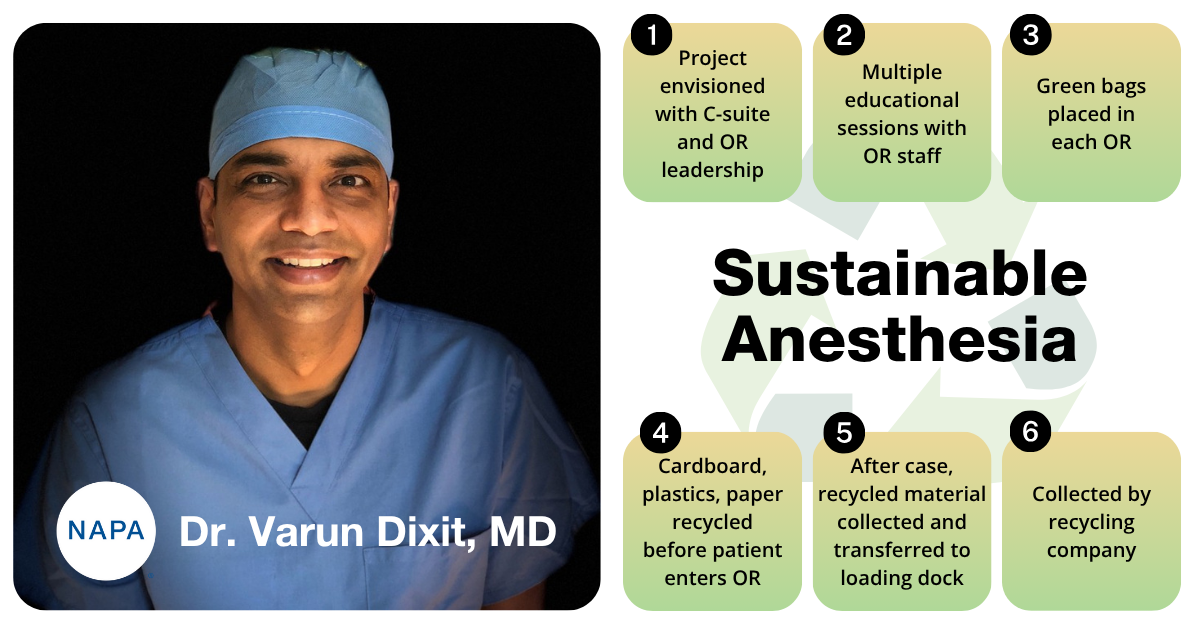
Dr. Varun Dixit, MD, is a leader in sustainable anesthesia practices at North American Partners in Anesthesia.
Q: How did your passion for sustainable anesthesia take shape, and what role has NAPA played?
For me, sustainability comes back to the fundamental promise of medicine: do no harm. We focus intensely on a single patient, but that patient belongs to the community and a planet that is impacted by the choices we make in the OR. Sustainability entails preserving resources for future generations while taking care of our needs.
Operating rooms are major source of waste produced in the hospital. It is inevitable to produce some waste while taking care of patients, some of this waste can be recycled and given a new life. I had started a recycling program in my last job in Maine which resulted in over 80,000 pounds of waste being recycled.
When I joined Henrico Doctor’s Hospital 8 yrs ago, I was determined to replicate and build the work I did in Maine. I started a similar recycling program in the Operating Rooms. Over the years, this program has grown to include other areas of hospital like Cath Lab and OB. We are currently recycling over 180,000 pounds of waste including hard plastic, cardboard and paper.
Building up on the success of recycling program, provided evidence for use of Low Anesthetic Gas use. The CRNAs and Anesthesiologists I work with were open to the evidence and willing to change how they practiced. We reduced Sevoflurane usage by almost 30%, saving thousands of dollars for the hospital but also saving carbon equivalent to hundreds and thousands of miles. This work was then presented to NAPA leadership who then adopted it as one of the CMS Quality metrics, across the company.
Recently Henrico Doctors’ Hospital disconnected piped Nitrous Oxide, which is a powerful greenhouse gas and Ozone depletion. This was a team worked accomplished by Hospital administration, Anesthesia department, Facilities management and OR leadership. This will prevent senseless waste of this gas in the environment.
Anesthesiologist - Riverside Smithfield Hospital - Full Time
Join a collaborative anesthesia care team where leadership supports innovation and quality patient care. $450K salary; $100K sign-on incentives; generous PTO.
I never set out to become a Chief Sustainability Officer. I was simply doing the work — recycling in the ORs, reducing greenhouse gases, and pushing forward whatever changes I could. When our new CMO arrived, he asked a simple question: “In what capacity are you doing all of this?” And my answer was, “I don’t have one. I’m just an anesthesiologist trying to do the right thing.”
Our CMO saw that sustainability in the OR needs a seat at the table where decisions are made. So he created the role so there would be a clear leader — someone who understands the OR, can speak the language of clinicians, and can work directly with executives, facilities, and supply chain.
It’s not a title for the sake of a title. It gives me the ability to move ideas forward faster, remove barriers, and turn small pilots into lasting institutional change. I’m still the same physician taking care of patients every day. The difference is now I can scale the things we believe in so they benefit the entire hospital and community — not just one OR at a time.
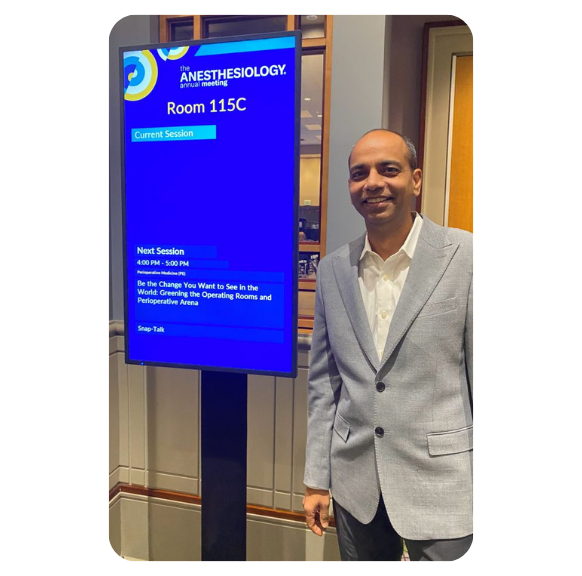
Dr. Varun Dixit, MD, is a frequent speaker on sustainable anesthesia, educating clinicians on environmentally responsible practices that improve patient care while reducing waste. At the ANESTHESIOLOGY 2025 conference, hosted by the American Society of Anesthesiologists, Dr. Dixit moderated a panel on advancing sustainability and resilience in anesthesia through smarter supply and equipment practices.
Q: Can you share a moment that shows how sustainable anesthesia has become part of everyday practice?
There was a day in the OR when a visiting nurse asked where to throw something away. One of our staff nurses pointed to the green recycling bag and explained exactly what belonged in it and why — the environmental impact, how we separate materials, the routine of it all. I was nearby, getting the patient ready, and they had no idea I was listening.
That moment made the biggest impression on me. It wasn’t a pilot or a push. It wasn’t dependent on whether I was standing there. It had become part of who we are — sustainable operating room practices, in action.
And that’s why the results continue to grow:
- ~180,000 pounds of OR waste recycled each year
- Low-flow anesthesia as standard practice
- Piped nitrous oxide disconnected, eliminating hundreds of metric tons of CO₂e annually
Anesthesiologist - Riverside Walter Reed Hospital - Full Time
Multiple schedules to choose from, including Call and Non-Call options. $450K salary; $100K sign-on incentives; up to 17 weeks PTO.
At Henrico Doctors’, we work as a real team with a spirit of trust, respect, and camaraderie. Anesthesiologists and CRNAs are side by side in the care-team model, supporting each other through every case. When you’re in the OR together every day, you build a family-like trust — you know how much everyone cares, and you want to help each other do the best for the patient.
Because of that, people feel comfortable raising concerns, asking questions, and trying something new. When I brought forward low-flow anesthesia, we talked about the evidence as a group, we tried it together, and we learned from each other. People kept the practice going because they understood the benefits. Similar approach was adopted with disconnecting piped Nitrous supply and the whole project was accomplished within two months. Providers were given opportunity to voice their concerns and suggestions and they were adequately addressed with the help of CRNA leadership.
I never believed change should come from the top down. What works is listening to what people need, making the right approach easier, and letting everyone take ownership. Our team not only cares for patients — we also care for our community — and, of course, for the planet we’re leaving for future generations.
Q: How did you begin — what was the first sustainability project that made you think, “I can make a difference”?
It started with a trash bag.
When I was working in Maine, I kept thinking about all the clean plastic we threw away in the OR. I saw the waste company’s logo on a dumpster and went to their local office to ask if they could recycle inside the hospital. The first few times, they didn’t really understand what I was asking. But I kept going back.
Eventually, the representative came to the hospital so I could show him exactly what I meant. After a cardiac case, we opened the OR trash bag and separated everything that could be recycled. When we weighed it, it came out to five or six pounds from just one surgery. Multiply that by every case, year after year, and the impact becomes enormous.
That moment became the beginning of a program that took nearly three years to fully implement — and ended up diverting tens of thousands of pounds of waste annually.
Some changes — like disconnecting piped nitrous — happened in six weeks because the support was there. Others took years. But the lesson is the same: If you believe in the mission, you keep going.
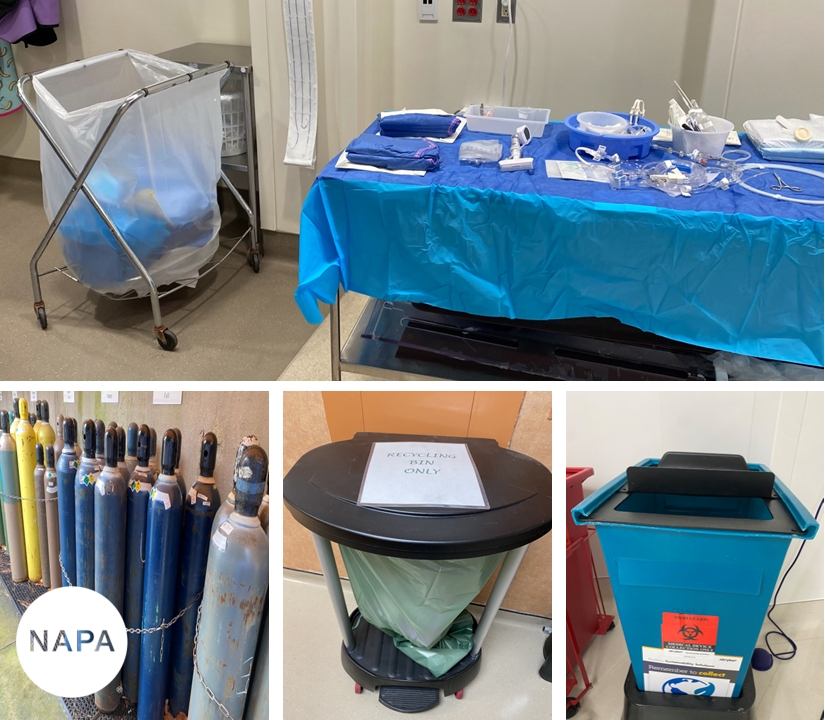
NAPA anesthesiologists, CRNAs, and CAAs practice sustainable anesthesia, such as using low-flow techniques and recycling anesthesia supplies.
Q: What would you tell clinicians who want to make an impact in anesthesia?
Start with one idea in one operating room. When the impact is clear and others can see the benefit for themselves, it can spread farther than you expect. I’ve watched changes move from our team, to our hospital, to NAPA sites nationwide, and even into national guidance through ASA.
What made a real difference for me is having leadership that listens. When I brought the data forward, NAPA didn’t just say “good job.” They helped turn low-flow anesthesia into a supported quality measure across all NAPA locations. And our CMO at Henrico Doctors’ created the CSO role to give me the support to move projects forward — not because I asked for a title, but because the work mattered.
If you want to make an impact, find a place where your voice is heard, where evidence matters, and where you can walk in with an idea and walk out with support to make real change happen.
Cardiac Anesthesiologist, MD - Henrico Doctors' Hospital
Join a collaborative anesthesia care team where leadership supports innovation and quality patient care. $550K salary; $50K sign-on incentives; generous PTO.
What I’m most proud of is when sustainability happens without anyone thinking about it — when a resident automatically turns down the gas, or a CRNA shows a student how to recycle in the OR. That’s when I know the work will outlast me.
I also think about my kids. They will inherit the results of what we do today. If I can leave behind practices that protect patients and protect their future at the same time, that’s what motivates me to keep going.
And I’ve learned you can’t scare people into caring. You can’t shame them into change. You show them what’s possible, you make it easier to do the right thing, and you build momentum one person at a time. When that becomes culture, that’s the impact — and that’s what I’m most proud of.
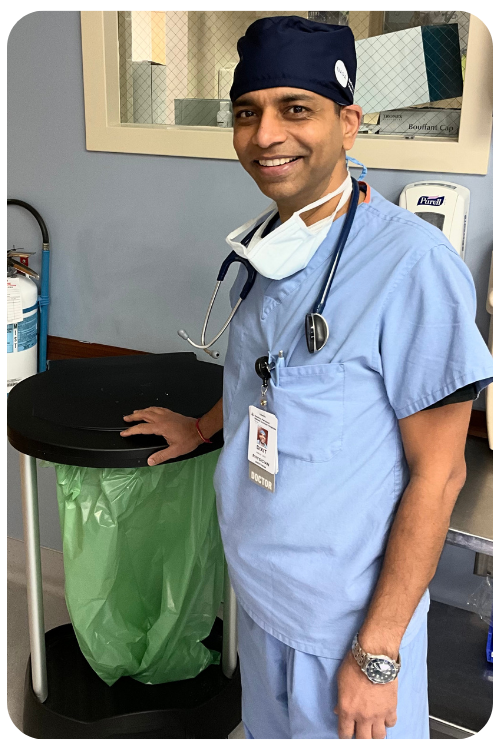
Dr. Varun Dixit, MD
Anesthesiologist and Chief Sustainability Officer, Henrico Doctors’ Hospital
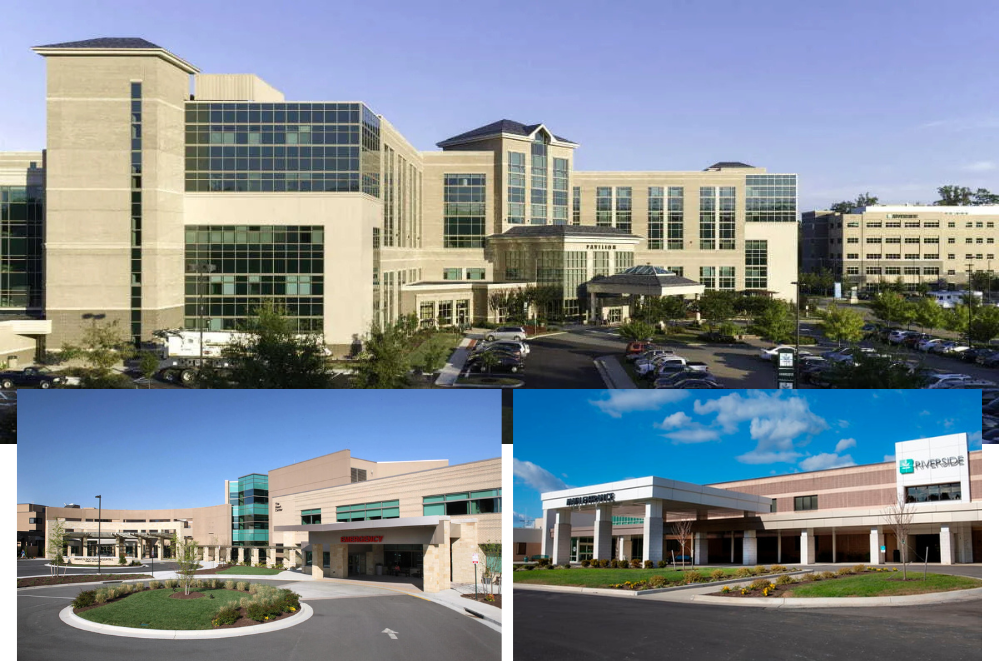
Discover Your Future in Anesthesia at Riverside Health
Our locations include: Riverside Regional Medical Center, Riverside Doctors' Hospital, Riverside Walter Reed, Riverside Doctors Surgery Center, Henrico Doctors' Hospital, Parham Hospital, and Retreat Hospital.
Advance your career where your expertise truly matters.
Explore career opportunities >
